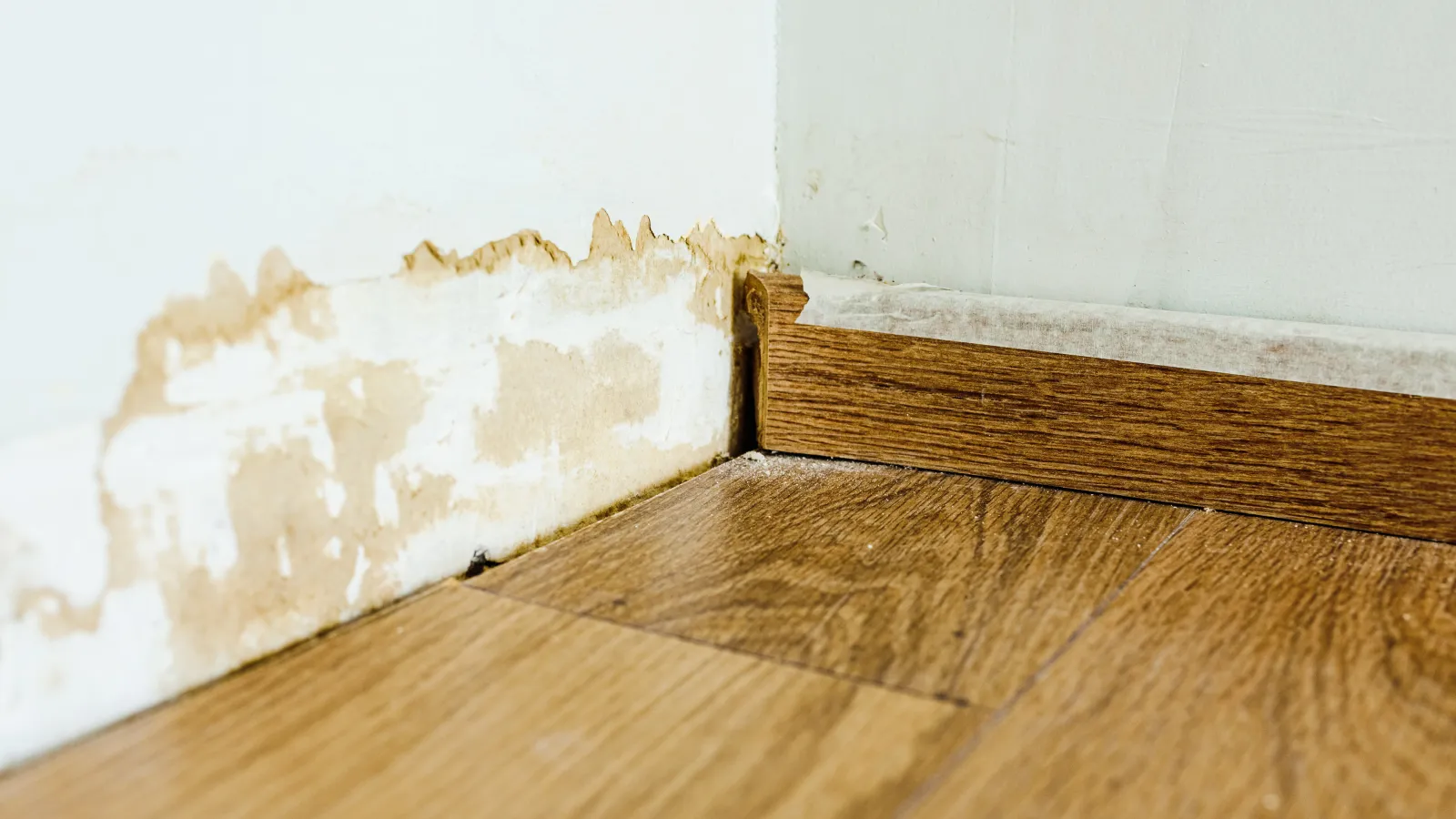Moisture inside your walls is often caused by wall condensation, which occurs when warm, humid air comes into contact with cooler wall surfaces, especially in poorly insulated areas. This can lead to sweating walls, damp spots, and even mold growth. Improving insulation, sealing air leaks, and controlling indoor humidity are key to preventing condensation inside your walls.
If you've noticed damp patches, peeling paint, or even mold forming indoors, you might be dealing with a surprisingly common issue: wall condensation. Wall condensation is not just a cosmetic concern, it's a sign that your home might have a moisture imbalance that needs attention.
Whether you see condensation spots on walls after a cold night or experience persistent damp walls during humid months, understanding what causes the issue is the first step toward fixing it. In many cases, insulation—or the lack of proper insulation—plays a central role.
Wall Condensation: What It Is and Why It Happens
Wall condensation happens when warm, moist air comes into contact with a cooler surface, like the inside of an exterior wall. That moisture-laden air cools rapidly, and the water vapor turns into liquid droplets. Over time, this can result in visible condensation spots on walls, warped drywall, or even black mold growth if the area remains damp.
These signs often appear in:
Basements and crawl spaces
Bathrooms and laundry rooms
Exterior walls, especially during colder months
Rooms with little to no insulation
Why Are My Walls Sweating?
While it might seem like water is somehow leaking into your home, the real reason why your walls are sweating is often due to air movement and temperature difference. When indoor humidity rises (whether from cooking, showering, or running appliances) and meets a poorly insulated or cold surface, moisture settles.
Another possible explanation: insufficient insulation or improper air sealing. The inside of walls can trap moisture when the exterior isn't properly protected or when gaps allow warm air to leak in and cool air to leak out. This process creates the perfect storm for condensation buildup.
Poor Insulation and Air Leaks
In older homes or those with deteriorating insulation, the barrier between indoor and outdoor air is compromised. That means interior walls can be much colder than they should be, especially in winter. As warm, humid air inside your home meets those cold walls, wall condensation begins to form.
Without adequate insulation to regulate temperature differences and prevent airflow through your walls, sweating walls are almost inevitable. USA Insulation often finds that upgrading wall insulation drastically reduces or eliminates moisture issues in affected areas.
Excess Indoor Humidity
Sometimes, the issue isn't your walls; it's your air. High indoor humidity levels caused by everyday activities can lead to persistent damp walls. If your home lacks adequate ventilation or uses older HVAC systems that don't control moisture well, that humid air lingers.
This problem is especially noticeable in homes with closed-off rooms, poor circulation, or no exhaust fans in kitchens or bathrooms. As a result, you may notice condensation spots on walls in these areas first.
How to Fix Sweating Walls
Sweating walls are often a sign that something in your home's insulation or air circulation isn't working as it should. The right solution will depend on the source of the moisture, but there are several effective ways to reduce condensation and prevent it from coming back. Here's where to start:
Improve Insulation in Exterior Walls
One of the most effective ways to stop wall condensation is to add or upgrade the insulation in your exterior walls. Insulation helps keep interior wall surfaces warmer and reduces the risk of condensation forming when warm air meets a cold surface.
USA Insulation offers premium wall insulation services that improve energy efficiency and help regulate indoor temperatures. With better insulation, your walls stay warm and dry.
Seal Air Leaks
Even if your walls are insulated, small air leaks can let in humid air that condenses once it hits cooler surfaces. Inspect your home for drafty windows, outlets, and baseboards. These tiny gaps often let in more air than you think.
Professional air sealing can go hand in hand with insulation upgrades. Sealing leaks around the inside of walls helps reduce airflow and lowers the risk of future condensation.
Control Indoor Humidity
Proper humidity control is crucial to preventing damp walls. That means:
Using dehumidifiers during humid seasons
Running exhaust fans in bathrooms and kitchens
Ensuring your HVAC system is properly sized and maintained
Ideally, indoor humidity should stay between 30-50%, especially during the colder months.
How to Treat Condensation on Walls
If you're already dealing with condensation spots on walls, you'll want to treat the issue quickly to prevent mold, water damage, and structural issues. Here's what you can do:
Dry the Affected Area
Start by wiping down any visible moisture and using a fan or dehumidifier to dry the room. It's critical to remove excess humidity so that mold doesn't develop.
Check for Mold Growth
If moisture has been building up for a while, inspect the area for dark or musty spots. Mold can grow within the walls, especially if the area remains damp. If you spot mold, professional remediation may be necessary.
Apply Mold-Resistant Paint (if applicable)
After treating the moisture issue and drying the surface, mold-resistant paint can help protect high-risk areas from future problems, but this should be a final step, not a solution in itself.
Upgrade Your Insulation
If sweating walls are a recurring problem, it's time to get serious about insulation. USA Insulation can evaluate your wall system and recommend the best insulation solution to help treat condensation on your walls and prevent future moisture buildup.
How to Prevent Moisture Inside Walls in the Future
Long-term protection from wall condensation involves a combination of insulation, air sealing, ventilation, and moisture control. Here's how to stay ahead of the problem:
Schedule an energy audit to identify weak points in insulation or ventilation
Upgrade wall insulation with a high-performance material like injection foam
Seal gaps in your building envelope to stop unwanted air exchange
Ventilate kitchens, bathrooms, and laundry rooms effectively
Use smart thermostats or humidistats to monitor and manage indoor conditions
With the right combination of insulation and air management, you'll stop wondering why your walls are sweating and start enjoying a more comfortable, energy-efficient home.
Summary: Why Is There Moisture Inside My Walls?
Excess moisture in your walls could indicate that your home may lack proper insulation, air sealing, or ventilation. Wall condensation forms when humid indoor air meets cold surfaces, especially on under-insulated walls.
From damp walls and condensation spots on walls to serious mold concerns, sweating walls can be both a comfort issue and a structural risk. However, there are many possible solutions.
At USA Insulation, we help homeowners address the root causes of moisture problems, starting with smarter insulation solutions that improve home comfort and protect your walls from condensation.
Get Ahead of Moisture Problems with USA Insulation
If you're tired of dealing with sweating walls, musty smells, or moisture inside your walls, it's time to take action. USA Insulation specializes in high-performance wall insulation and air sealing that keeps homes dry, efficient, and comfortable year-round.
Don't wait for small moisture issues to become big problems. Contact USA Insulation today for a free estimate and discover how the right insulation can protect your home from condensation.



